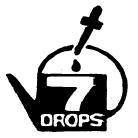TTAB Reverses Refusal to Register Background Design for PING Golf Clubs
Overturning the PTO's refusal to register, the Board ruled that the design mark shown immediately below for "golf clubs" is supported by specimens that bear the design mark with the words PING USA on one portion and a "G2 design" on the other. In re Karsten Mfg. Corp., Serial No. 78347910 (Sept. 12, 2005) [not citable].

Rule 2.51(a)(1) states that "the drawing of the mark must be a substantially exact representation of the mark as used on or in connection with the goods and/or services." The Examining Attorney contended that Applicant Karsten did not meet this requirement because its drawing does not include the terms PING, G2 and USA, which appear on the specimen of use.

Karsten argued that its background "wedge" design is distinctive, and it provided 23 declarations from golf customers and dealers, all stating that the wedge design is distinctive separate and apart from the writing on the design. [The declarations included a depiction of the design rotated 180 degrees, as it appears on the specimen of use].
The Board noted that a background design used for the display of a word mark is separately registrable without proof of secondary meaning if it is "distinctive or unique enough to create a commercial impression as an indication of origin separate and apart from the remainder of the mark." Common basic shapes, such as circles, ovals, and triangles, are not regarded as inherently distinctive, though they may be registrable under Section 2(f).
The Board concluded here that the wedge background design creates a separate and distinct impression and that the specimen supports registration of the wedge design alone. "Both the overall shape and the two internal figures, which appear in different colors, are somewhat unusual, and the resulting combination is also unusual."
The Board found it important that the design is used on the head of a golf club and, as the declarations showed, the shape and two-tone pattern would be discernible from a distance, even though the writing on the design would not be. [TTABlog note: there is no reason why the mark has to appear on the golf club head, so is this a valid point? Suppose it appeared only on the packaging?]
Finally, the Board distinguished the current case from In re Chemical Dynamics Inc., 5 USPQ2d 1828 (Fed. Cir. 1988), in which an applicant sought to register the medicine droplet and dropper portion of the design shown below. The court held that the three elements of the background in the mark shown below (the dropper, droplet, and watering can) were "interrelated elements of a unified design." Here, Karsten seeks to register the entire background design, not merely a portion.
 Therefore the Board reversed the refusal to register, but it "suggested" that Karsten submit a new drawing with the mark rotated 180 degrees.
Therefore the Board reversed the refusal to register, but it "suggested" that Karsten submit a new drawing with the mark rotated 180 degrees.Text Copyright 2005 John L. Welch.




0 Comments:
Post a Comment
<< Home